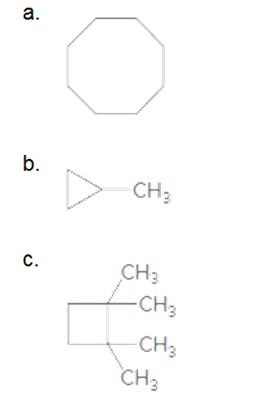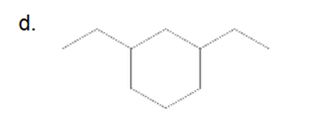
GENERAL,ORGANIC, & BIOLOGICAL CHEM-ACCES
4th Edition
ISBN: 9781265982959
Author: SMITH
Publisher: MCG
expand_more
expand_more
format_list_bulleted
Concept explainers
Textbook Question
Chapter 12, Problem 47P
Give the IUPAC name for each cycloalkane.


Expert Solution & Answer
Want to see the full answer?
Check out a sample textbook solution
Students have asked these similar questions
Please answer 1, 2 and 3 on the end
In the box below, specify which of the given compounds are very soluble in polar aprotic solvents. You may select more than one compound. Choose one or more: NaCl NH4Cl CH3CH2CH2CH2CH2CN CH3CH2OH hexan-2-one NaOH CH3SCH3
On the following structure, select all of the atoms that could ACCEPT a hydrogen bond. Ignore possible complications of aromaticity. When selecting be sure to click on the center of the atom.
Chapter 12 Solutions
GENERAL,ORGANIC, & BIOLOGICAL CHEM-ACCES
Ch. 12.1 - How many hydrogen atoms are present in each...Ch. 12.1 - Which formulas represent acyclic alkanes and which...Ch. 12.2 - Are the compounds in each pair constitutional...Ch. 12.2 - Draw two isomers with molecular formula C6H14 that...Ch. 12.2 - Prob. 12.3PCh. 12.2 - Classify the carbon atoms in each compound as 1°,...Ch. 12.2 - Prob. 12.4PCh. 12.2 - Prob. 12.5PCh. 12.2 - Prob. 12.6PCh. 12.2 - Prob. 12.7P
Ch. 12.2 - Prob. 12.8PCh. 12.2 - Prob. 12.9PCh. 12.4 - Give the IUPAC name for each compound.Ch. 12.4 - Prob. 12.10PCh. 12.4 - Give the IUPAC name for each compound....Ch. 12.4 - Prob. 12.5PPCh. 12.4 - Prob. 12.6PPCh. 12.4 - Prob. 12.12PCh. 12.5 - Prob. 12.13PCh. 12.5 - Prob. 12.14PCh. 12.5 - Give the IUPAC name for each compound.Ch. 12.5 - Prob. 12.15PCh. 12.7 - Answer the following questions about pentane...Ch. 12.7 - Prob. 12.17PCh. 12.7 - Prob. 12.18PCh. 12.8 - Prob. 12.19PCh. 12.9 - Prob. 12.20PCh. 12.9 - Prob. 12.21PCh. 12.9 - Prob. 12.22PCh. 12 - Prob. 23PCh. 12 - Prob. 24PCh. 12 - The waxy coating on the surface of apple skins...Ch. 12 - Prob. 26PCh. 12 - Classify each carbon as 1°, 2°, 3°, or 4°. a....Ch. 12 - Give the structure of an alkane that fits each...Ch. 12 - Prob. 29PCh. 12 - Label each pair of compounds as constitutional...Ch. 12 - Consider compounds A, B, and C. Label each pair of...Ch. 12 - Consider compounds D,E, and F. Label each pair of...Ch. 12 - Prob. 33PCh. 12 - Consider compounds A-E and label each pair of...Ch. 12 - Draw structures that fit the following...Ch. 12 - Draw the five constitutional isomers having...Ch. 12 - Prob. 37PCh. 12 - Prob. 38PCh. 12 - Draw the five constitutional isomers that have...Ch. 12 - Pristane is a high molecular weight alkane found...Ch. 12 - Give the IUPAC name for each of the five...Ch. 12 - Give the IUPAC name for each of the five cyclic...Ch. 12 - Give the IUPAC name for each compoundCh. 12 - Give the IUPAC name for each compound.Ch. 12 - Give the IUPAC name for each compound. c....Ch. 12 - Give the IUPAC name for each compound.Ch. 12 - Give the IUPAC name for each cycloalkane.Ch. 12 - Give the IUPAC name for each ccycloalkane.Ch. 12 - Prob. 49PCh. 12 - Give the structure corresponding to each IUPAC...Ch. 12 - Each of the following IUPAC names is incorrect....Ch. 12 - Each of the following IUPAC names is incorrect....Ch. 12 - Draw three constitutional isomers having molecular...Ch. 12 - Draw four constitutional isomers having molecular...Ch. 12 - Draw a skeletal structure for each compound octane...Ch. 12 - Convert each compound to a skeletal structure CH3(...Ch. 12 - Convert each skeletal structure to a complete...Ch. 12 - Convert each skeletal structure to a complete...Ch. 12 - Which compound in each pair has the higher melting...Ch. 12 - Which compound in each pair has the higher boiling...Ch. 12 - Branching in an alkane chain decreases surface...Ch. 12 - Explain why the boiling points of heptane [CH3( CH...Ch. 12 - Explain why hexane is more soluble in...Ch. 12 - Mineral oil and Vaseline are both mixtures of...Ch. 12 - Write a balanced equation for the combustion of...Ch. 12 - Write a balanced equation for the combustion of...Ch. 12 - Write a balanced equation for the incomplete...Ch. 12 - Prob. 68PCh. 12 - Prob. 69PCh. 12 - Prob. 70PCh. 12 - Prob. 71PCh. 12 - Prob. 72PCh. 12 - Prob. 73PCh. 12 - Prob. 74PCh. 12 - Prob. 75PCh. 12 - Prob. 76PCh. 12 - Prob. 77PCh. 12 - Prob. 78PCh. 12 - Prob. 79PCh. 12 - A major component of animal fat is tristearin, (a)...Ch. 12 - Answer the following questions about the alkane...Ch. 12 - Prob. 82PCh. 12 - Answer the questions in Problem 12.81 for the...Ch. 12 - Prob. 84PCh. 12 - Prob. 85CPCh. 12 - Draw the structure of the 12 constitutional...Ch. 12 - Cyclopentane has a higher boiling point than...Ch. 12 - Prob. 88CP
Knowledge Booster
Learn more about
Need a deep-dive on the concept behind this application? Look no further. Learn more about this topic, chemistry and related others by exploring similar questions and additional content below.Similar questions
- Rank the compounds below from lowest to highest melting point.arrow_forward18 Question (1 point) Draw the line structure form of the given partially condensed structure in the box provided. :ÖH HC HC H2 ΙΩ Н2 CH2 CH3 CH3 partially condensed formarrow_forwardsomeone else has already submitted the same question on here and it was the incorrect answer.arrow_forward
- The reaction: 2NO2(g) ⇌ N2O4(g) is an exothermic reaction, ΔH=-58.0 kJ/molrxn at 0°C the KP is 58.If the initial partial pressures of both NO2(g) and N2O4(g) are 2.00 atm:A) Is the reaction at equilibrium? If not, what is the value of Q? B) Which direction will the reaction go to reach equilibrium? C) Use an ICE table to find the equilibrium pressures.arrow_forwardThe dissociation of the weak acid, nitrous acid, HNO2, takes place according to the reaction: HNO2 (aq) ⇌ H+(aq) + NO2–(aq) K=7.2 X 10-4 When 1.00 mole of HNO2 is added to 1.00 L of water, the H+ concentration at equilibrium is 0.0265 M.A) Calculate the value of Q if 1.00 L of water is added? B) How will reaction shift if 1.00 L of water is added?arrow_forwardSuppose a certain copolymer elastomeric material “styrene-butadiene rubber”) contains styrene ("S") monomers –(C8H8)– and butadiene ("B") monomers –(C4H6)– and that their numerical ratio S:B = 1:8. What is the mass ratio mS:mB of the two monomers in the material? What is the molecular mass M of a macromolecule of this copolymer with degree of polymerization n = 60,000? Data: AC = 12.01 u, AH = 1.008 u.arrow_forward
- Lab Questions from Lab: Gravimetric Determination of Calcium as CaC2O4•H2O What is the purpose of the methyl red indicator? Why does a color change to yellow tell you that the reaction is complete? Why is the precipitate rinsed with ice-cold water in step 4? Why not room temperature or hot water? Why is it important that the funnels be placed in a desiccator before weighing (steps 1 and 5)?arrow_forwardWhat mass of ethylene glycol, HOCH2CH2OH, Mustbe added to 5.50 kg of water to antifreeze that would work for the car radiator to -10.0 degrees celcius? MM (g/mol): 62.07arrow_forwardWhat is the molarity of a 0.393 m glucose solution if its density is 1.16 g/mL? MM glucose 180.2 g/molarrow_forward
- The rate constant for the decay of a radioactive element is 2.28 × 10⁻³ day⁻¹. What is the half-life of this element in days?arrow_forwardHandwritten pleasearrow_forwardChoose the best reagents to complete the following reaction. i H A B 1. CH3CH2Na 2. H3O+ 1. CH3CH2MgBr 2. H3O+ 1. CH3MgBr Q C 2. H3O+ 1. H3O+ D 2. CH3MgBr 00 OH Q E CH³MgBrarrow_forward
arrow_back_ios
SEE MORE QUESTIONS
arrow_forward_ios
Recommended textbooks for you
 Introductory Chemistry: An Active Learning Approa...ChemistryISBN:9781305079250Author:Mark S. Cracolice, Ed PetersPublisher:Cengage Learning
Introductory Chemistry: An Active Learning Approa...ChemistryISBN:9781305079250Author:Mark S. Cracolice, Ed PetersPublisher:Cengage Learning Organic And Biological ChemistryChemistryISBN:9781305081079Author:STOKER, H. Stephen (howard Stephen)Publisher:Cengage Learning,
Organic And Biological ChemistryChemistryISBN:9781305081079Author:STOKER, H. Stephen (howard Stephen)Publisher:Cengage Learning, General, Organic, and Biological ChemistryChemistryISBN:9781285853918Author:H. Stephen StokerPublisher:Cengage Learning
General, Organic, and Biological ChemistryChemistryISBN:9781285853918Author:H. Stephen StokerPublisher:Cengage Learning- Chemistry: Matter and ChangeChemistryISBN:9780078746376Author:Dinah Zike, Laurel Dingrando, Nicholas Hainen, Cheryl WistromPublisher:Glencoe/McGraw-Hill School Pub Co
 Chemistry for Today: General, Organic, and Bioche...ChemistryISBN:9781305960060Author:Spencer L. Seager, Michael R. Slabaugh, Maren S. HansenPublisher:Cengage Learning
Chemistry for Today: General, Organic, and Bioche...ChemistryISBN:9781305960060Author:Spencer L. Seager, Michael R. Slabaugh, Maren S. HansenPublisher:Cengage Learning ChemistryChemistryISBN:9781305957404Author:Steven S. Zumdahl, Susan A. Zumdahl, Donald J. DeCostePublisher:Cengage Learning
ChemistryChemistryISBN:9781305957404Author:Steven S. Zumdahl, Susan A. Zumdahl, Donald J. DeCostePublisher:Cengage Learning

Introductory Chemistry: An Active Learning Approa...
Chemistry
ISBN:9781305079250
Author:Mark S. Cracolice, Ed Peters
Publisher:Cengage Learning

Organic And Biological Chemistry
Chemistry
ISBN:9781305081079
Author:STOKER, H. Stephen (howard Stephen)
Publisher:Cengage Learning,

General, Organic, and Biological Chemistry
Chemistry
ISBN:9781285853918
Author:H. Stephen Stoker
Publisher:Cengage Learning

Chemistry: Matter and Change
Chemistry
ISBN:9780078746376
Author:Dinah Zike, Laurel Dingrando, Nicholas Hainen, Cheryl Wistrom
Publisher:Glencoe/McGraw-Hill School Pub Co

Chemistry for Today: General, Organic, and Bioche...
Chemistry
ISBN:9781305960060
Author:Spencer L. Seager, Michael R. Slabaugh, Maren S. Hansen
Publisher:Cengage Learning

Chemistry
Chemistry
ISBN:9781305957404
Author:Steven S. Zumdahl, Susan A. Zumdahl, Donald J. DeCoste
Publisher:Cengage Learning
Nomenclature: Crash Course Chemistry #44; Author: CrashCourse;https://www.youtube.com/watch?v=U7wavimfNFE;License: Standard YouTube License, CC-BY